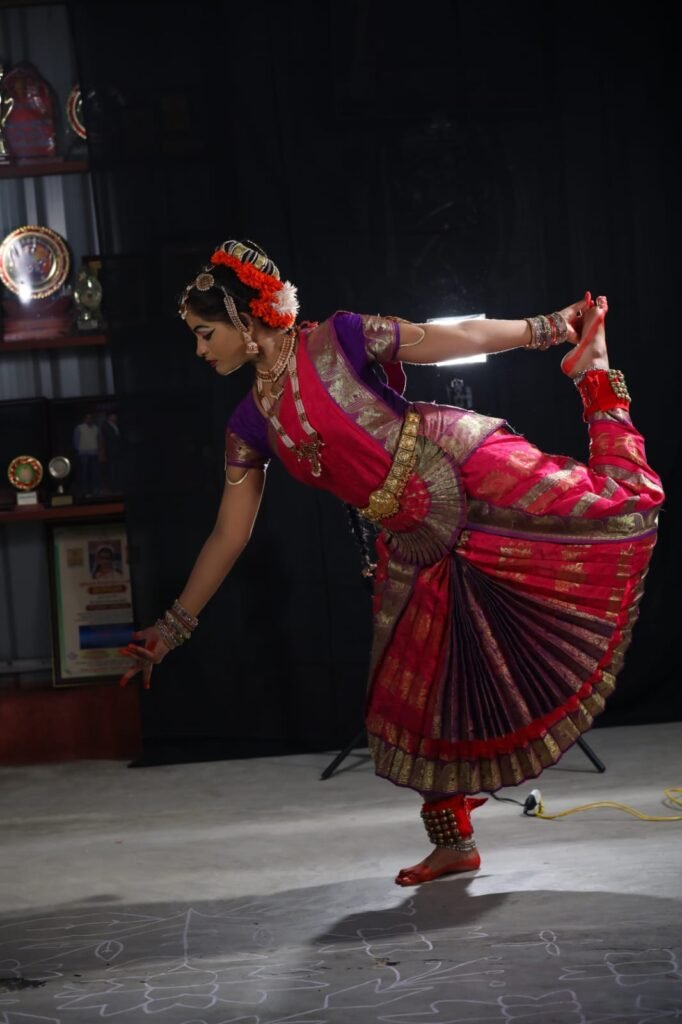The Graceful Flame of Southern India
Bharatanatyam, one of the oldest and most revered classical dance forms of India, is a radiant expression of devotion, discipline, and divine storytelling. Originating from the temples of Tamil Nadu, this sacred art form seamlessly combines emotion, rhythm, and intricate movement into a captivating visual language that transcends time and culture.
A Divine Legacy: From Temple Ritual to Global Stage
Rooted in the Natya Shastra, Bharatanatyam was originally performed by Devadasis as a form of sacred offering in temple courtyards. These dancers would enact stories from Hindu mythology, primarily praising Lord Shiva, Vishnu, and the goddesses, through expressive gestures (mudras), facial expressions (abhinaya), and rhythmic footwork. Over time, especially during the colonial era, the tradition faced decline. However, the early 20th-century revival, led by cultural pioneers like Rukmini Devi Arundale and E. Krishna Iyer, brought Bharatanatyam from temple sanctums to modern theatre stages, preserving its purity while expanding its reach.

The Essence of Bharatanatyam
Bharatanatyam follows a structured repertoire known as Margam, which includes elements like Alarippu (invocation), Jatiswaram (pure dance), Varnam (the centerpiece combining nritta and abhinaya), Padams and Javalis (expressive storytelling pieces), and concludes with Tillana (a lively rhythmic finale). Each piece serves a purpose—whether it’s to invoke, narrate, or mesmerize. The dancer uses every muscle to articulate emotion, using the eyes to communicate subtle nuances and the feet to command rhythm.
Visual Elegance and Musical Harmony
The costume of a Bharatanatyam dancer is a vibrant, pleated saree stitched to facilitate dramatic poses and movement, adorned with traditional temple jewelry, including a headpiece (nethi chutti), nose ring, earrings, and ankle bells (ghungroos). The elaborate makeup accentuates facial expressions, crucial for storytelling. Musically, Bharatanatyam is deeply rooted in the Carnatic tradition, often featuring live accompaniment with instruments like the mridangam, nattuvangam, flute, and veena. The lyrics, usually in Tamil, Telugu, or Sanskrit, form the poetic soul of the performance.
Contemporary Voice, Eternal Core
While Bharatanatyam has remained anchored in tradition, it continues to evolve as a medium for contemporary expression. Dancers today explore themes ranging from mythology and spirituality to social issues and human emotions, using the classical framework to engage modern audiences. Despite innovation, the form retains its structural discipline, aesthetic richness, and spiritual intent, ensuring that every performance is both timeless and timely.
At Sri Radha Krishna Kalakshetra, we honor the sanctity and sophistication of Bharatanatyam by offering rigorous training grounded in traditional pedagogy. Our curriculum emphasizes not just physical technique but also emotional depth, cultural literacy, and spiritual understanding. Under the guidance of experienced gurus, students learn to embody the dance with grace, purpose, and poise. We encourage performance opportunities, scholarly exploration, and cross-cultural collaboration to ensure that each dancer evolves as an artist, thinker, and cultural ambassador.
Step into the world of Bharatanatyam with us—where every gesture tells a story and every movement is an offering to the divine.

Sri Radhakrishna Kalakshetra, established in 1998, is a premier institute dedicated to preserving and promoting Indian classical dance and music through disciplined training, cultural programs, and global performances.
All Rights Reserved © 2025 | Sri Radhakrishna Kalakshetra